Chemistry > GIZMOS > Explore Learning. Student Exploration: Ionic Bonds. GIZMO. Questions and Answers > (All)
Explore Learning. Student Exploration: Ionic Bonds. GIZMO. Questions and Answers >
Document Content and Description Below
Name: Hannah Robb Student Exploration: Ionic Bonds Vocabulary: chemical family, electron affinity, ion, ionic bond, metal, nonmetal, octet rule, shell, valence electron, ♫heavy metal ♫... Prior Knowledge Questions (Do these BEFORE using the Gizmo.) 1. Nate and Clara are drawing pictures with markers. There are 8 markers in a set. Nate has 9 markers and Clara has 7. What can Nate and Clara do so that each of them has a full set? 2. Maggie is sitting at a table with Fred and Florence. Maggie has 10 markers, but Fred and Florence each have only 7 markers. How can they share markers so each has 8? Gizmo Warm-up Just like students sharing markers, atoms sometimes share or swap electrons. By doing this, atoms form bonds. The Ionic Bonds Gizmo™ allows you to explore how ionic bonds form. 1. Each atom consists of a central nucleus and several shells that contain electrons. The outermost electrons are called valence electrons. (Inner electrons are not shown.) How many valence electrons does each atom have? Sodium: Chlorine: 2. Click Pause ( ). Elements can be classified as metals and nonmetals. Metals do not hold on to their valence electrons very tightly, while nonmetals hold their electrons tightly. Electron affinity is a measure of how tightly the valence electrons are held. A. Try pulling an electron away from each atom. Based on this experiment, which atom is a metal? Which is a nonmetal? B. Try moving an electron from the metal to the nonmetal. What happens? __________ Introduction: Some of the particles that make up atoms have an electrical charge. Electrons are negatively charged, while protons are positively charged. Particles with opposite charges (+ and –) attract, while particles with the same charge (+ and + or – and –) repel. Question: What happens when atoms gain or lose electrons? 1. Count: Electrons move around the nucleus of atoms in specific shells, shown by the rings around the atoms in the Gizmo. The first ring holds two electrons, and the second holds eight. (Electrons in the inner rings are not shown; you can assume these rings are full.) A. Observe the sodium and chlorine atoms. Assuming that the inner rings are full of electrons, how many electrons are there total in each atom? Sodium: Chlorine: B. Each atom is neutrally charged, which means that each atom has the same number of protons and electrons. Based on this, how many protons are in each atom? Sodium: Chlorine: 2. Observe: Most atoms are stable with a configuration of eight valence electrons. This is known as the octet rule. How many valence electrons does each atom have? Sodium: Chlorine: 3. Form a bond: Each electron has a charge of 1–, and each proton has a charge of 1+. You can calculate the charge of an atom by subtracting the number of electrons from the number of protons. Move an electron from the sodium to the chlorine atom. A. What are the charges of each atom now? Sodium: __1+__ Chlorine: _1-__ Turn on Show charge to check. These charged atoms are called ions. B. Is each ion stable? Explain. 4. Think and discuss: Why is there an attraction between the two ions in this chemical bond? Activity B: Ionic compounds Get the Gizmo ready: • Click Reset. Turn off Show charge. • Select Lithium (Li) and Oxygen (O). Question: How are ionic compounds formed? 1. Observe: Look at the red lithium atom and the blue oxygen atom. Recall that most atoms are stable when their outermost ring has eight electrons. (Some atoms, such as lithium and beryllium, are stable when their outermost ring has two electrons.) A. How many electrons will the lithium atom give up to become stable? B. How many electrons does the oxygen atom need to become stable? C. Can a stable compound be made from these two atoms? Explain why or why not. 2. Form bonds: Click Add metal to add another lithium atom, and then transfer electrons from the lithium to the oxygen. Click Check. A. Did you make a stable compound? B. Turn on Show formula. What is the formula of this compound? C. Turn on Show charge. What is the charge of each ion? 3. Practice: Use the Gizmo to create stable compounds from the combinations given below. After transferring electrons, arrange the atoms to demonstrate the attraction between positively charged ions and negatively charged ions. Click Check to check each compound. For each compound, click the camera ( ) to take a snapshot. Paste each image into a blank document to turn in with this worksheet. Write the ionic charges (such as Ca2+) and chemical formulas below. Ionic charges Chemical formula A. Lithium and fluorine: B. Beryllium and oxygen: C. Magnesium and fluorine: D. Aluminum and chlorine: E. Beryllium and nitrogen: Extension: Chemical families Get the Gizmo ready: • Select Lithium (Li) from the Select a metal list. • You will need a periodic table for this activity. Introduction: The periodic table arranges elements by size and property. The vertical columns represent chemical families, or groups of elements with similar chemical properties. Question: How are elements arranged into chemical families? 1. Observe: Drag the nonmetal into the trash ( ) so there is only the one lithium atom visible. A. How many valence electrons does lithium have? B. Now look at your periodic table. Find lithium (Li) in the first column. Other than lithium, which element from the Gizmo is also in this column? C. Choose this element. How many valence electrons does this element have? 2. Gather data: Four other pairs of elements in the same chemical family are listed below. List the number of valence electrons in each element. Beryllium Magnesium Nitrogen Phosphorus Oxygen Sulfur Fluorine Chlorine 3. Analyze: What pattern do you see? 4. Make a rule: Based on your data, how are elements arranged into chemical families? 5. Infer: Look at your periodic table. How many valence electrons would you find for elements in each family? Think and discuss: How do you think the number of valence electrons relates to an element’s chemical properties? [Show More]
Last updated: 2 weeks ago
Preview 1 out of 7 pages
.png)
Reviews( 0 )
Recommended For You
SCIENCE 101> GIZMOS > Gizmos Student Exploration| Refraction. Questions and Answers (All)
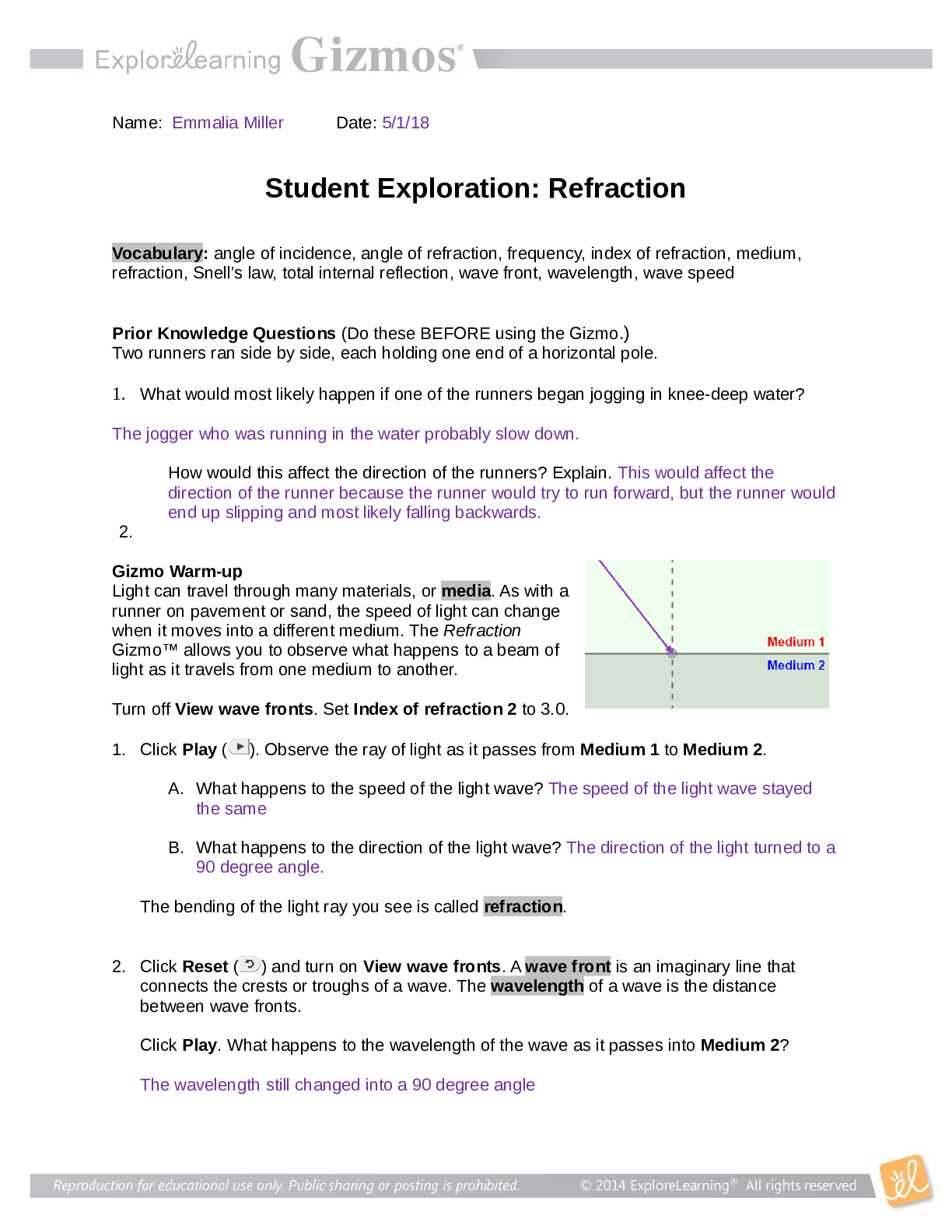
Gizmos Student Exploration| Refraction. Questions and Answers
Vocabulary: angle of incidence, angle of refraction, frequency, index of refraction, medium, refraction, Snell’s law, total internal reflection, wave front, wavelength, wave speed Prior Knowledge...
By Quiz Merchant , Uploaded: May 11, 2021
$7
Biology> GIZMOS > BIO 101 Fast Plants 1 Growth and Genetics Gizmos Student Exploration: Fast Plants 1 – Growth and Genetics (All)

BIO 101 Fast Plants 1 Growth and Genetics Gizmos Student Exploration: Fast Plants 1 – Growth and Genetics
Student Exploration: Fast Plants® 1 – Growth and Genetics Note to teachers and students: The Fast Plants® Gizmo was created in collaboration with the Wisconsin Fast Plants Program of the University of...
By Crum , Uploaded: Sep 05, 2022
$9.5
Biology> GIZMOS > Fast Plants GIZMO. Growth and Genetics Student Exploration: Fast Plants 1 – Growth and Genetics. (All)
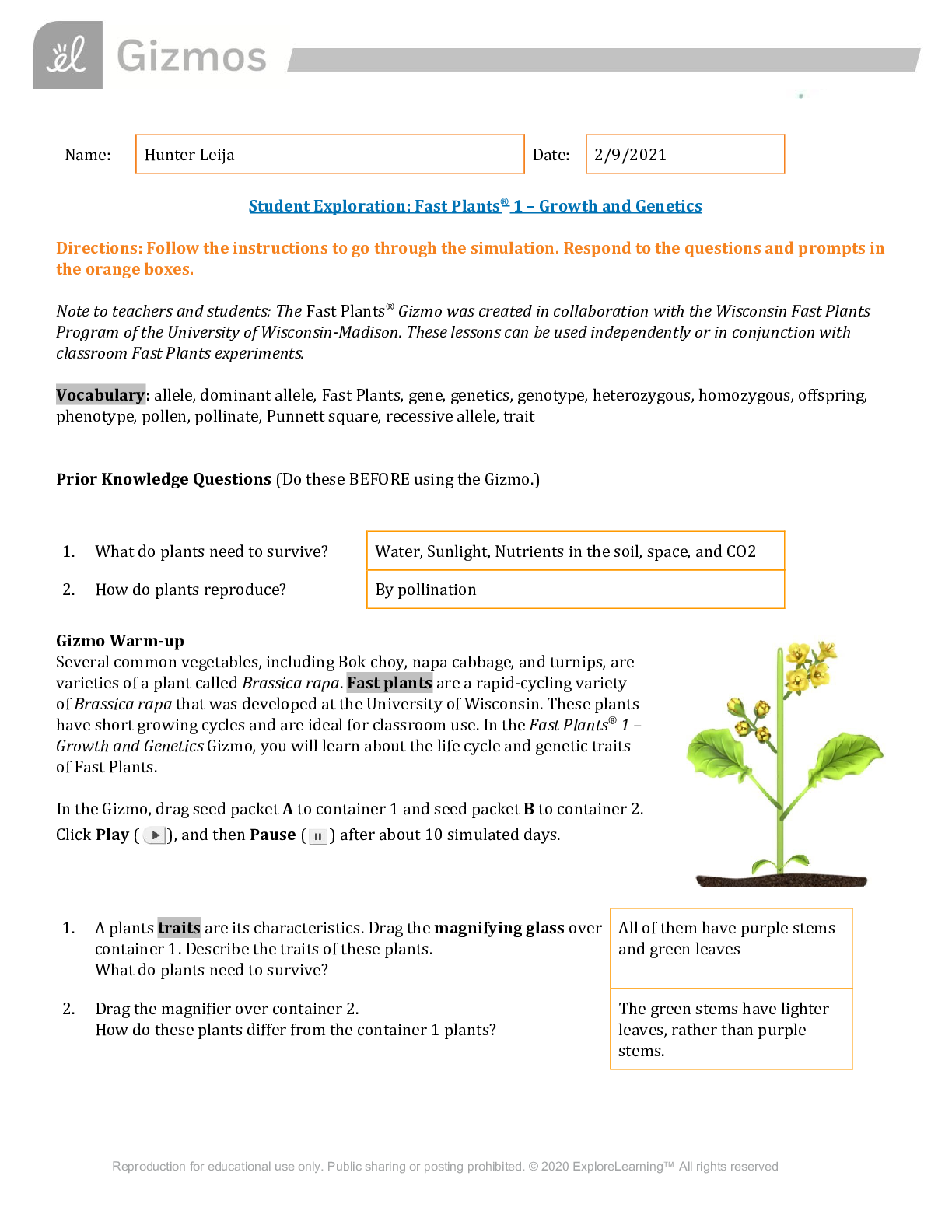
Fast Plants GIZMO. Growth and Genetics Student Exploration: Fast Plants 1 – Growth and Genetics.
Directions: Follow the instructions to go through the simulation. Respond to the questions and prompts in the orange boxes. Note to teachers and students: The Fast Plants ® Gizmo was created in col...
By jimmydarts , Uploaded: Sep 24, 2021
$10
Chemistry> GIZMOS > Dehydration Synthesis GIZMO: Student Exploration: Dehydration Synthesis. 100% Correct Exam Content. (All)
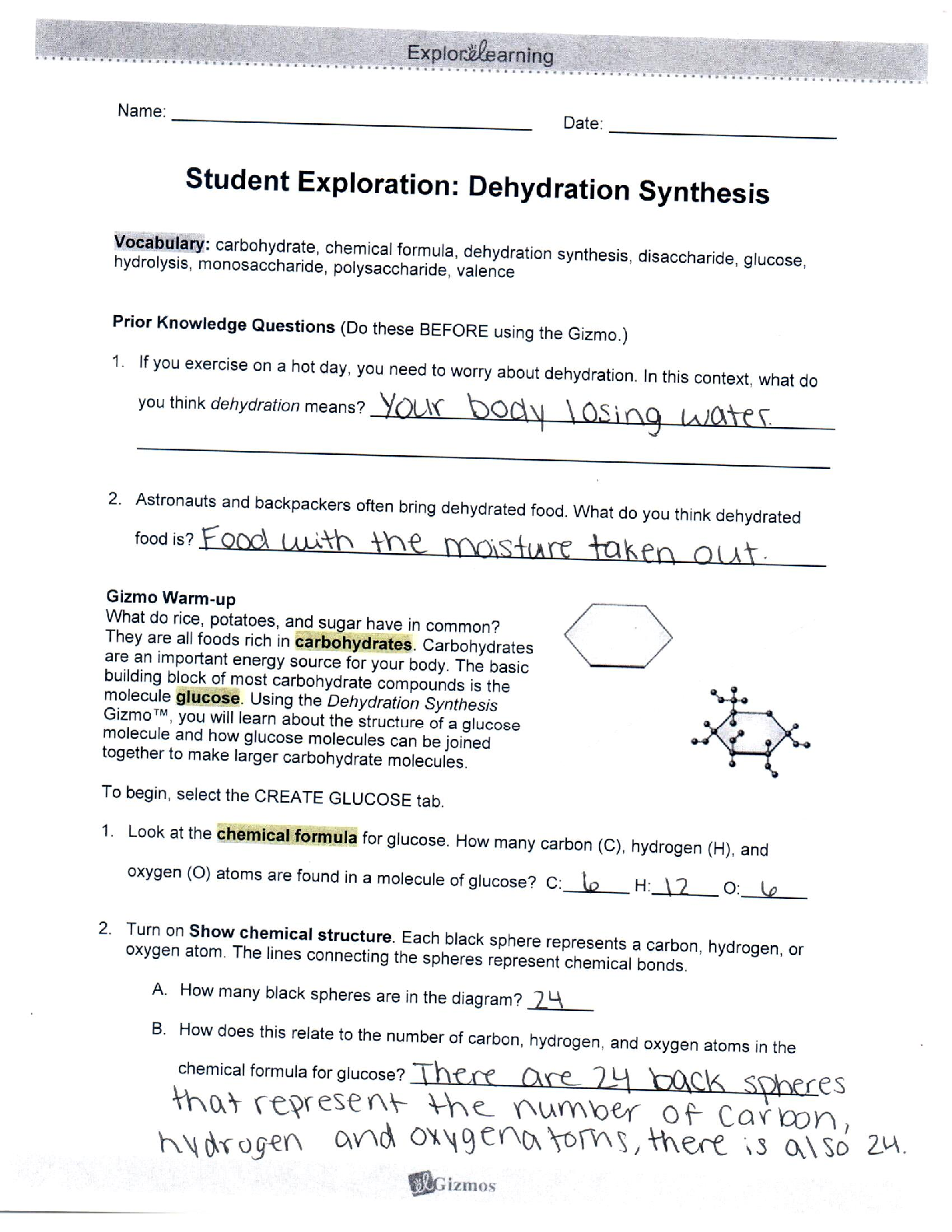
Dehydration Synthesis GIZMO: Student Exploration: Dehydration Synthesis. 100% Correct Exam Content.
Name: C Date: June 23, 2020 Student Exploration: Dehydration Synthesis Vocabulary: carbohydrate, chemical formula, dehydration synthesis, disaccharide, glucose, hydrolysis, monosacch aride, polysaccha...
By Kirsch , Uploaded: Nov 29, 2020
$9
Physics> GIZMOS > GIZMOs - Student Exploration: Radiation - ANSWER KEY (All)
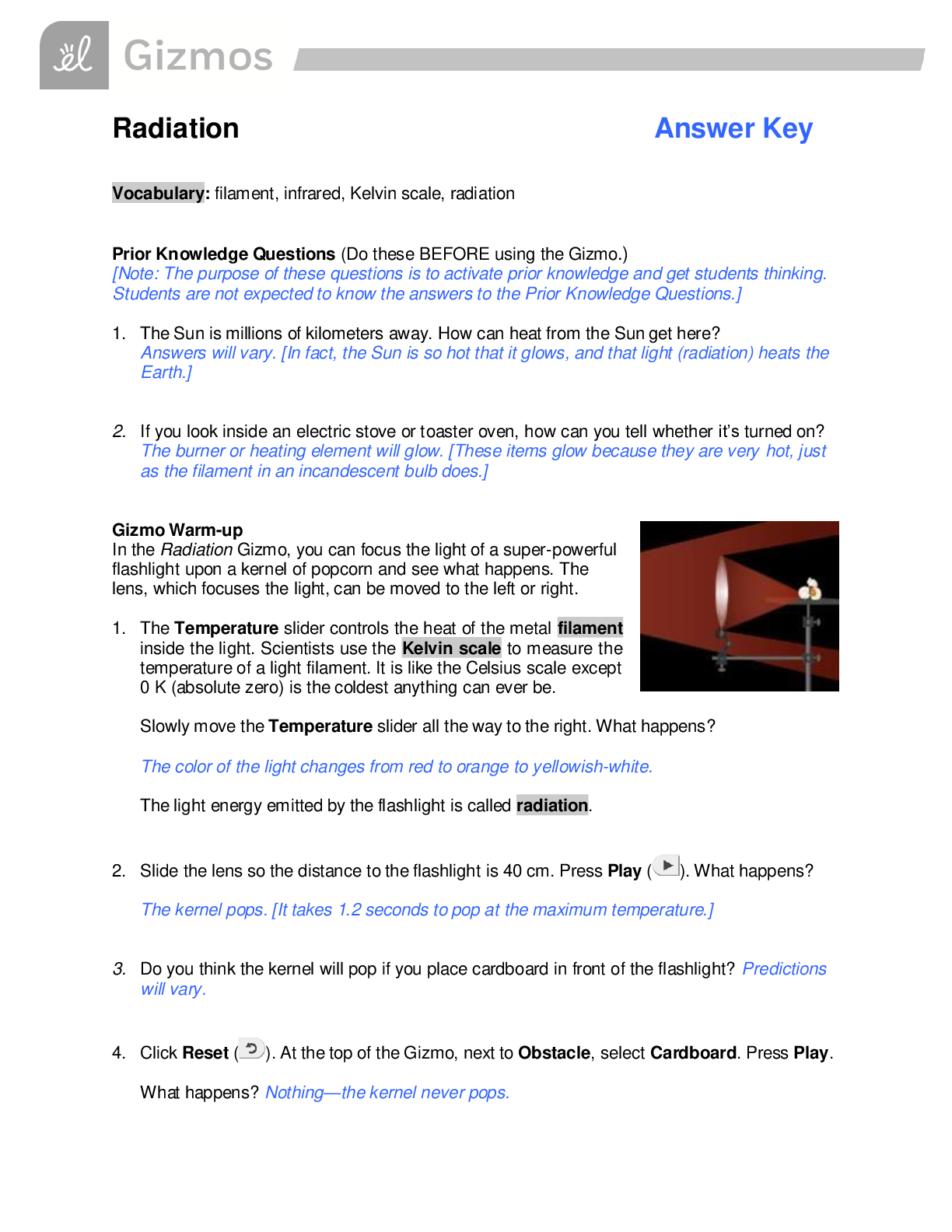
GIZMOs - Student Exploration: Radiation - ANSWER KEY
Radiation Answer Key Vocabulary: filament, infrared, Kelvin scale, radiation Prior Knowledge Questions (Do these BEFORE using the Gizmo.) [Note: The purpose of these questions is to activate prior...
By Academia1434 , Uploaded: Apr 22, 2021
$7
Chemistry> GIZMOS > Gizmos - Student Exploration: Moles -ANSWER KEY (All)
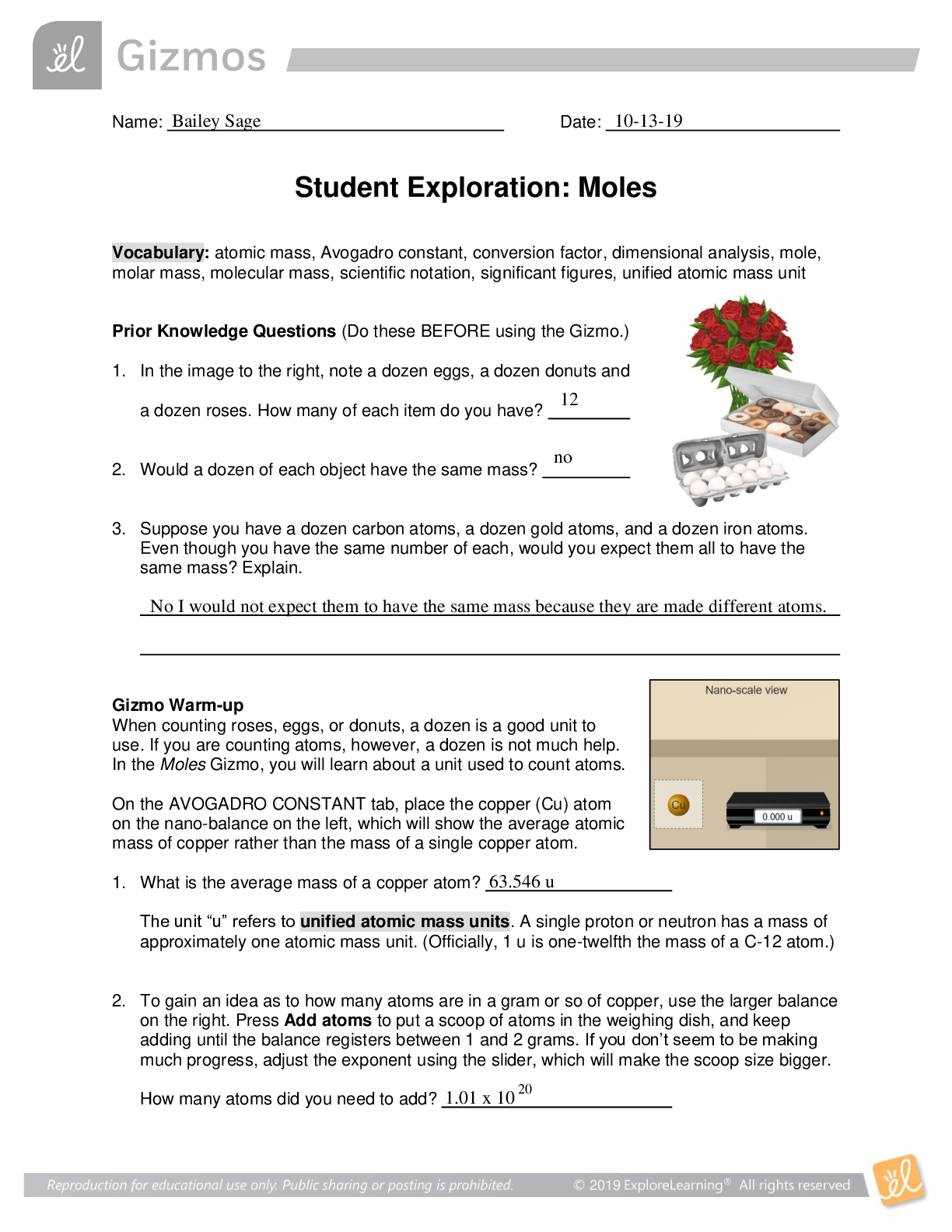
Gizmos - Student Exploration: Moles -ANSWER KEY
Name: Date: Student Exploration: Moles Vocabulary: atomic mass, Avogadro constant, conversion factor, dimensional analysis, mole, molar mass, molecular mass, scientific notation, significant figures,...
By Academia1434 , Uploaded: Jun 17, 2021
$11
Physics> GIZMOS > GIZMOs - Student Exploration: Air Track (Complete solution) 100% SCORE (All)
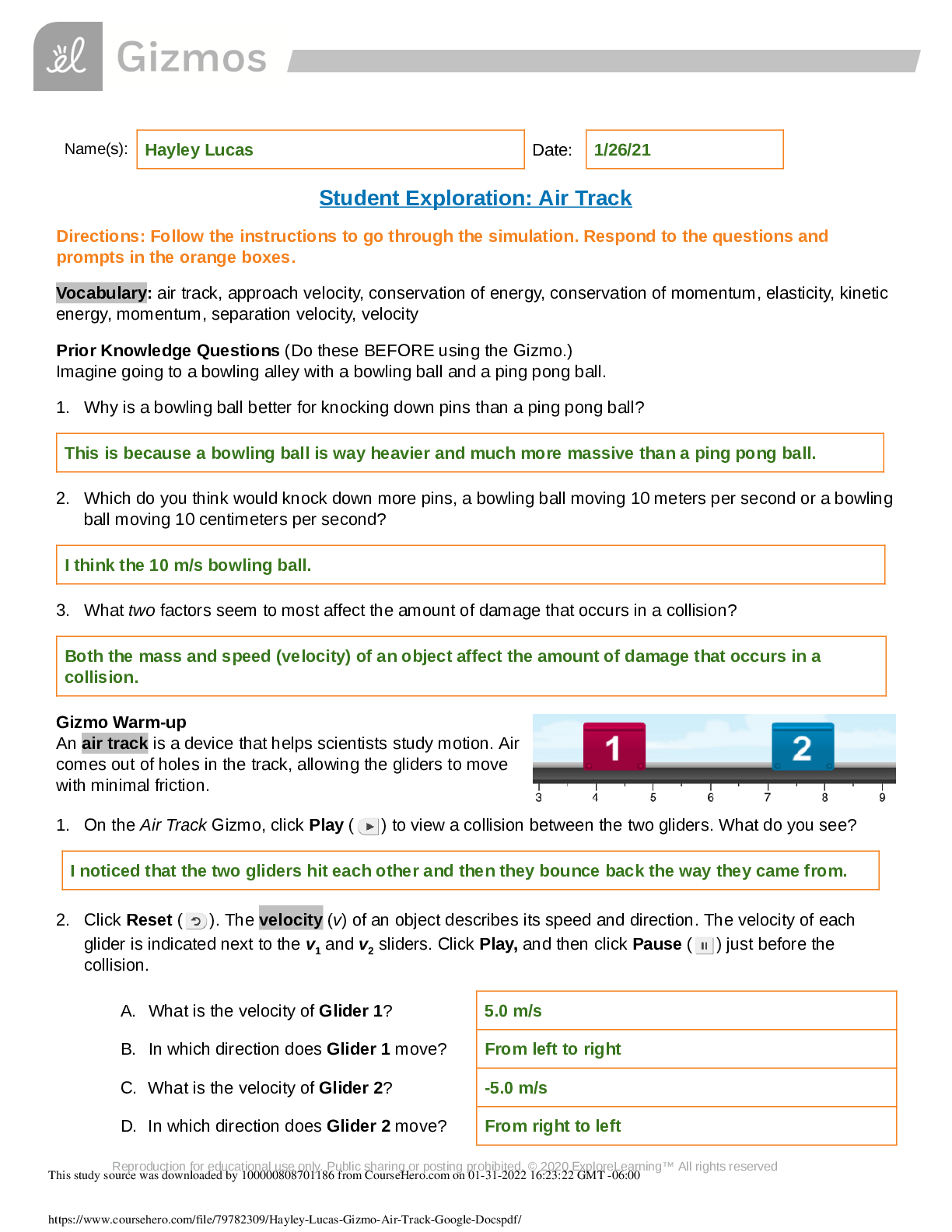
GIZMOs - Student Exploration: Air Track (Complete solution) 100% SCORE
GIZMOs - Student Exploration: Air Track (Complete solution) 100% SCORE Vocabulary: air track, approach velocity, conservation of energy, conservation of momentum, elasticity, kinetic energy, momentu...
By Academia1434 , Uploaded: Feb 01, 2022
$11
Health Care> GIZMOS > Explore Learning. GIZMO: Student Exploration: Ionic Bonds (All)
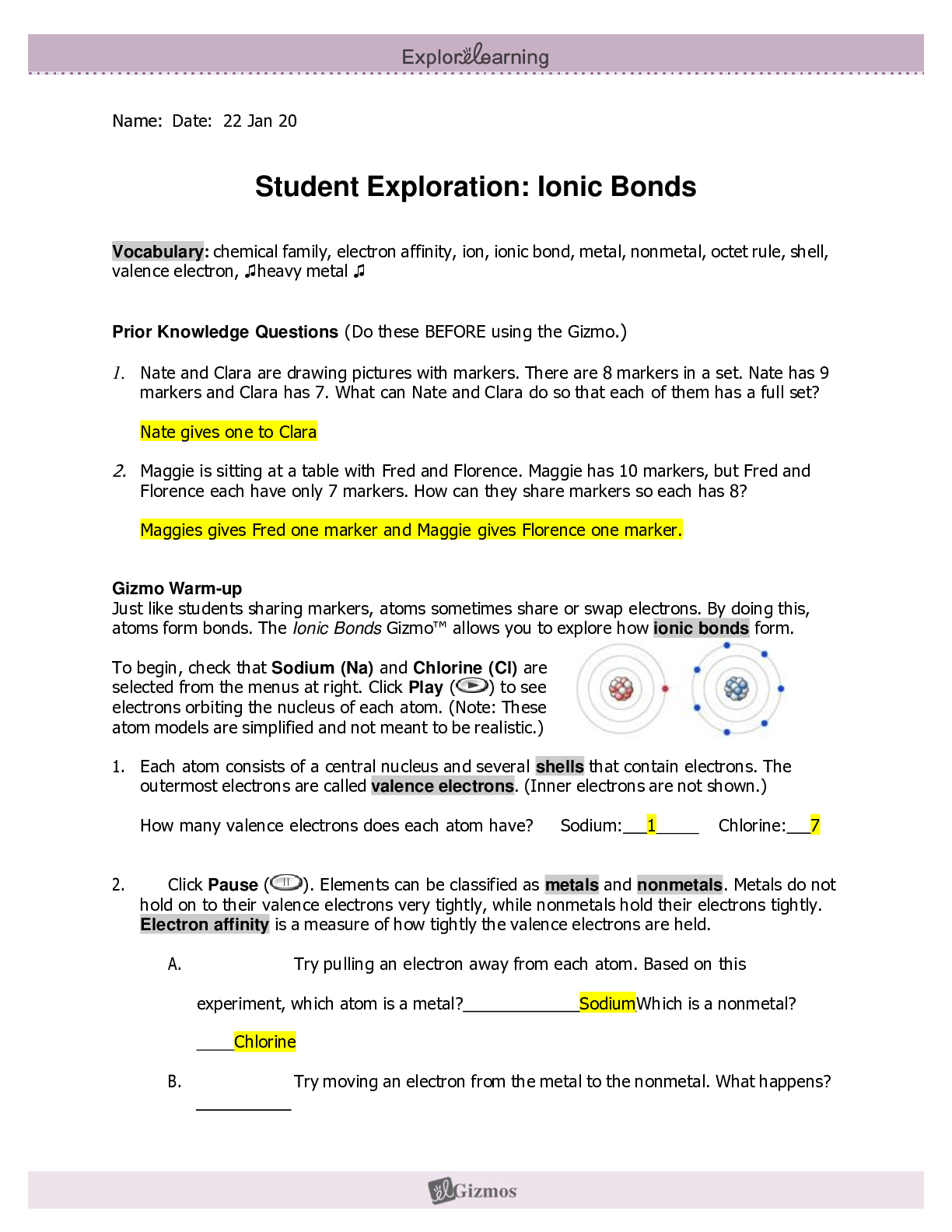
Explore Learning. GIZMO: Student Exploration: Ionic Bonds
Explore Learning. GIZMO: Student Exploration: Ionic BondsExplore Learning. GIZMO: Student Exploration: Ionic BondsExplore Learning. GIZMO: Student Exploration: Ionic BondsExplore Learning. GIZMO: Stud...
By DOCTOR BEN , Uploaded: Jun 23, 2022
$15
Physics> GIZMOS > GIZMO - Student Exploration: Sine, Cosine, and Tangent Ratios [Answer Key] (All)
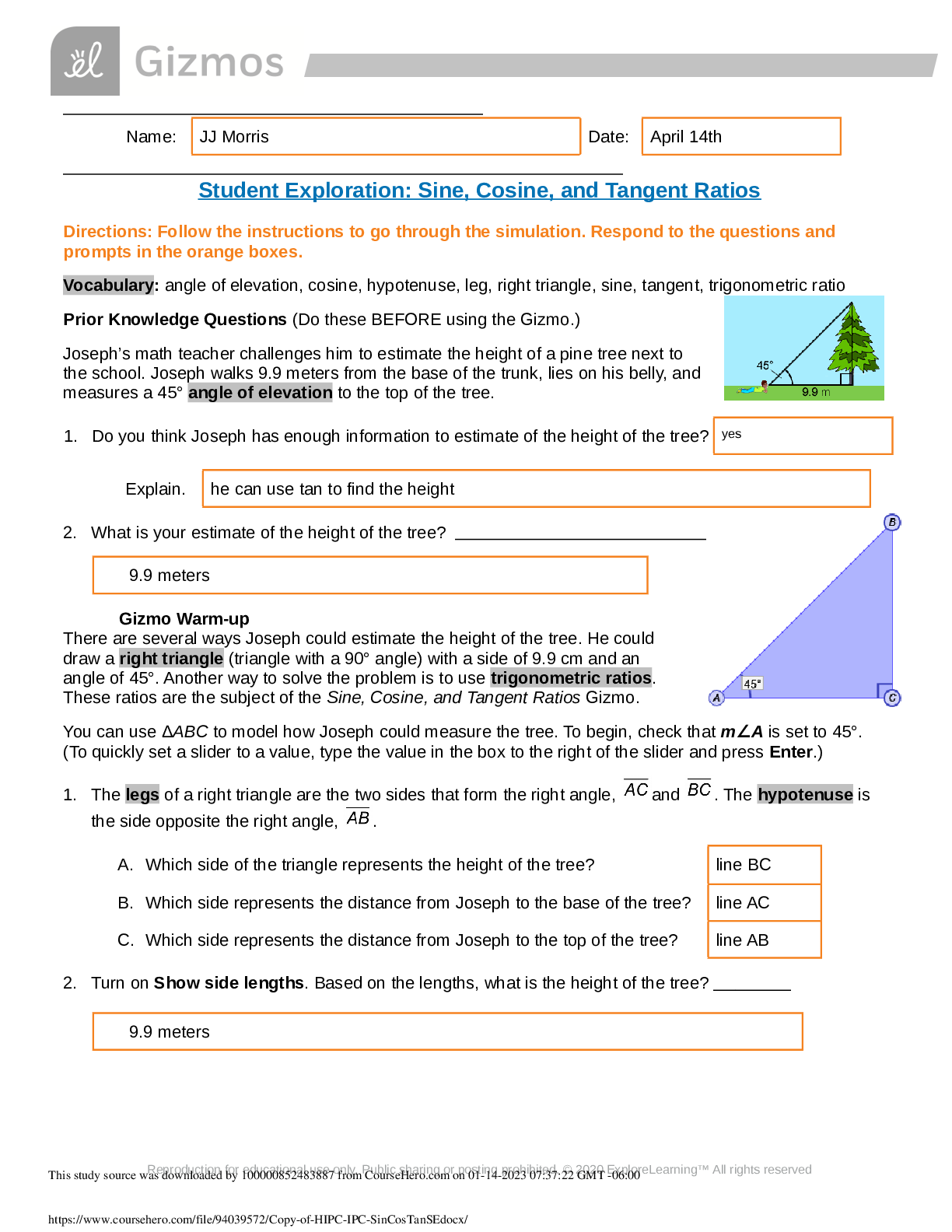
GIZMO - Student Exploration: Sine, Cosine, and Tangent Ratios [Answer Key]
GIZMO - Student Exploration: Sine, Cosine, and Tangent Ratios [Answer Key]
By Academia1434 , Uploaded: Jul 31, 2021
$10
Chemistry> GIZMOS > GIZMO LEARNING. CHEM SECTION 3M1L2M1 Density Gizmo. Student Exploration: Density Laboratory NCVPS Chemistry Fall 2014 Vocabulary: buoyancy, density, graduated cylinder, mass, matter, scale, volume (All)

GIZMO LEARNING. CHEM SECTION 3M1L2M1 Density Gizmo. Student Exploration: Density Laboratory NCVPS Chemistry Fall 2014 Vocabulary: buoyancy, density, graduated cylinder, mass, matter, scale, volume
Name: Harlee Davis Date: Feb. 06, 2017 Student Exploration: Density Laboratory NCVPS Chemistry Fall 2014 Vocabulary: buoya...
By QuizMaster , Uploaded: Feb 12, 2021
$10
Document information
Connected school, study & course
About the document
Uploaded On
Dec 22, 2020
Number of pages
7
Written in
Additional information
This document has been written for:
Uploaded
Dec 22, 2020
Downloads
2
Views
1325






